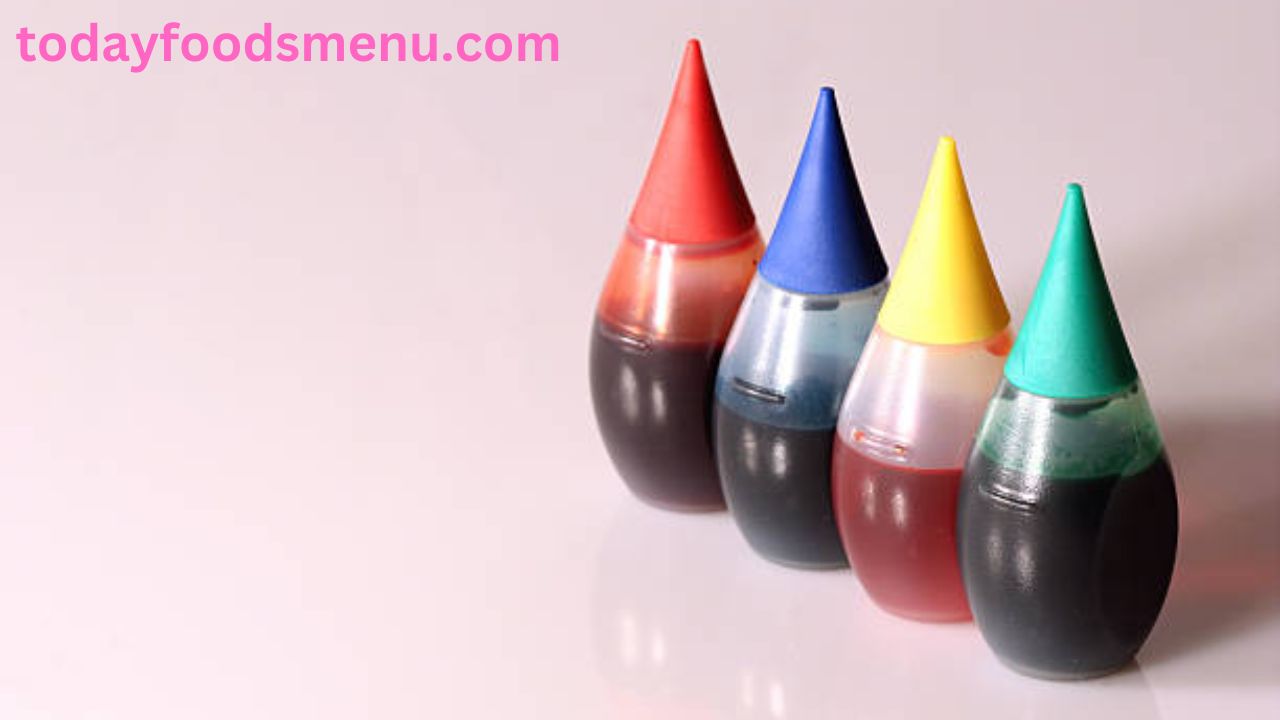Introduction
Colour is vital in making dishes appealing and delicious in baking and food decoration. Oil based food colouring is one of the most popular options for adding colour to various culinary creations. Unlike traditional water-based food dyes, oil based food colouring offers unique advantages, particularly for specific applications such as chocolate, buttercream, and other fat-based recipes. This article will explore the intricacies of oil based food coloring, from its Composition to its uses and advantages, and how to choose the right product for your needs.
What is oil based food coloring?
Oil based food coloring is a type of dye designed specifically to mix well with oils and fats. This quality makes it ideal for use in recipes where water-based dyes would not perform well. Oil-based food coloring is made from pigments suspended in oil, allowing it to blend seamlessly into oil-rich recipes without separating or altering the texture. This versatility is particularly beneficial for bakers and chefs who want vibrant colours in their creations, such as cakes, candies, and frosting.
The Composition of oil based food coloring
Understanding the Composition of oil-based coloring is essential for knowing how to use it effectively. The primary ingredients in these colours include:
- Colourants: These are the actual pigments that provide colour. Commonly used colourants are natural or synthetic, ranging from fruit and vegetable extracts to synthetic dyes.
- Carrier Oil: This is the oil that suspends the pigments. Common carrier oils include soybean oil, canola oil, and coconut oil. The choice of oil can affect the final flavour and texture of the food.
- Stabilizers: Some oil-based colourings may include stabilizers to ensure that the pigments remain evenly distributed in the oil. This feature helps maintain the consistency of the color throughout the product’s shelf life.
Advantages of Using oil based food coloring
There are several advantages to using food coloring in your culinary creations. Here are some of the most notable benefits:
Enhanced Color Vibrancy
One key advantage of oil based food coloring is its ability to produce vibrant colours. Unlike water-based dyes that may appear diluted, oil-based food coloring can achieve bold, bright hues that stand out. This quality is particularly important for professional bakers and chefs who aim to impress with visually stunning presentations.
Better Mixing with Fat-Based Ingredients
Oil based food colouring is designed to blend well with fats and oils, making it ideal for chocolate, butter, or cream recipes. When adding colour to chocolate ganache or buttercream frosting, food colouring ensures that the colour remains consistent without compromising the texture or flavour of the final product.
Resistance to Fading
Another significant benefit of food colouring is its resistance to fading over time. Water-based dyes may lose their vibrancy when exposed to air or light, but oil-based food colouring maintains its colour even after prolonged exposure. This quality is particularly useful for decorated cakes or confections that may sit out for extended periods.
Common Uses of oil based food coloring
Oil based food coloring is incredibly versatile and can be used in various culinary applications. Here are some common uses:
Decorating Cakes and Cupcakes
One of the most popular food colouring uses is decorating cakes and cupcakes. Bakers can achieve stunning frosting, fondant, and cake batter colours, creating visually appealing treats. Whether aiming for a rainbow effect or elegant pastels, oil-based food colouring provides the perfect solution.
Chocolate and Confectionery
Oil based food coloring is ideal for coloring chocolate and other fat-based confections. When working with melted chocolate or candy melts, water-based dyes can cause the chocolate to seize or become grainy. However, oil-based food coloring ensures your chocolate maintains its smooth texture while achieving vibrant colours.
Sauces and Dressings
Beyond baking, food coloring can also enhance the appearance of sauces and dressings. By adding a few drops of colour to salad dressings or sauces, chefs can elevate the presentation of their dishes. This application is particularly popular in gourmet dining, where aesthetics are as important as flavour.

Creating Edible Art
Food colouring can be used to create edible art for those who enjoy artistic food presentations. Bakers and decorators can use these colours to paint cakes, cookies, and other desserts, adding intricate designs and patterns. The ability to blend and layer colours allows for limitless creativity in edible artistry.
How to Use oil based food coloring
Using oil based food coloring is simple, but a few tips can help you achieve the best results.
Measuring and Mixing
When using oil based food coloring, it’s essential to measure carefully. Start with a small amount of colour; a little can go a long way. For frosting or batter, gradually add the oil-based food coloring, mixing thoroughly until you reach the desired shade. This approach allows you to control the intensity of the color without overwhelming the mixture.
Combining with Other Ingredients
Oil based food coloring works best when combined with ingredients that contain fat or oil. For example, when coloring chocolate, melt the chocolate first and then add the oil-based food coloring while stirring continuously. This method ensures even distribution and prevents any separation.
Storing Leftover Coloring
If you have leftover food coloring, store it in a cool, dry place away from direct sunlight. To avoid contamination and preserve quality, make sure the container is firmly sealed. Most oil based food colorings have a long shelf life, making them a convenient addition to your baking supplies.
Choosing the Right oil based food coloring
With many options available, choosing the right oil based food coloring for your needs can be overwhelming. Here are some factors to consider:
Quality of Ingredients
When selecting oil-based coloring, it is important to look for high-quality ingredients. Opt for products made with natural colourants whenever possible, as they tend to be safer and more environmentally friendly. Reading labels and researching brands can help you find the best options.
Range of Colors
Different brands offer varying colour ranges. If you’re looking for specific shades or want to experiment with colour mixing, choose a brand that provides a diverse palette. Some companies even offer sets with multiple colours, allowing for greater creativity in your baking.
Intended Use
Consider what you plan to use the food coloring for. A versatile brand that works well with frostings and batters is ideal if you primarily bake cakes and cupcakes. For those focused on chocolate work or candy making, ensure the product is specifically formulated for those applications.
Popular Brands of oil based food coloring
Several brands have gained popularity for their high-quality oil based food coloring.
Wilton
A well-known brand in the baking sector is Wilton. It offers a range of food coloring options. Its products are widely used by home bakers and professionals and are known for their vibrant colours and excellent mixing properties.
AmeriColor
AmeriColor is another popular choice among bakers. Their food coloring comes in various shades and is praised for its ease of use and ability to blend seamlessly into multiple recipes. AmeriColor is particularly favoured for cake decorating and fondant applications.
Chefmaster
Chefmaster specializes in food colourings, offering an extensive range of oil-based colours suitable for various applications. Their products are designed to provide consistent results, making them a reliable choice for amateur and professional bakers.
Safety and Regulations
Safety should always be a priority when working with food colorings. Food coloring is generally safe for consumption when used as directed. However, it’s essential to check for allergens and ensure that the products comply with local food safety regulations. Always read labels carefully and choose products that have undergone testing for safety and quality.
Tips for Working with oil based food coloring
Working with oil based food coloring can be a fun and creative experience, but a few tips can help you get the best results:
Start Small
When adding colour, start with a small amount and gradually increase it until you achieve the desired shade. This practice prevents you from over-colouring and allows more control over the outcome.
Experiment with Mixing
Don’t be afraid to mix different colours to create unique shades. Food colouring can be blended to achieve various hues, allowing for greater creativity in your baking. Record your colour combinations to replicate your favourite shades in the future.
Practice Patience
Sometimes, achieving the perfect color may take some time and experimentation. Be patient and willing to adapt your techniques as needed. Baking is as much about the process as the final product, so enjoy the journey!
The Environmental Impact of Food Colorings
As consumers become more aware of environmental issues, the impact of food colourings is gaining attention. Many choose natural colourants from fruits, vegetables, and other plant-based sources. These natural alternatives can reduce the environmental footprint associated with synthetic dyes. Consider brands that prioritize sustainability and environmentally friendly practices when using food colouring.
The Future of oil based food coloring
As the culinary world continues to evolve, the future of oil food coloring looks promising. Innovations in food technology are likely to lead to even more vibrant and sustainable options. As consumers demand cleaner and safer ingredients, manufacturers will likely adapt by creating oil based food colorings that align with these values.
Conclusion
In conclusion, oil-based food coloring is an essential tool for bakers and chefs looking to enhance the appearance of their culinary creations. Its ability to blend seamlessly with oils and fats makes it ideal for various applications, from decorating cakes to coloring chocolate. With


